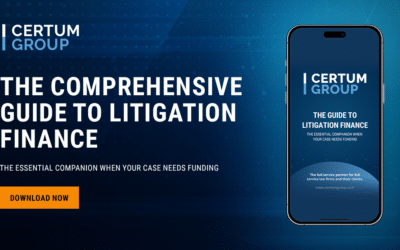Memorial Day has come and gone, and June is now upon us, unofficially marking the start of summer. As many of us gear up to tackle our long-neglected yards in preparation for the hot weather ahead, we’re not just grabbing the lawnmower and garden hose. We’re also reaching for the power trimmer, the grill cleaner, and the potting soil. To do the job right, we need the full toolkit.
Similarly, in-house legal professionals increasingly require access to the full suite of litigation risk transfer solutions to effectively manage their responsibilities. Certum recently conducted a survey among in-house legal professionals, and the results shed light on a notable trend: while awareness of litigation finance is high among these professionals, understanding and awareness of litigation insurance remain low.
This gap presents significant opportunities for in-house professionals to enhance their risk management strategies by embracing the complete range of available litigation risk transfer tools. And this presents a chance for outside counsel to play a pivotal role in educating their clients about the diverse range of solutions available in the market today.
If you want to learn more, you can download a copy of our survey results here.
High Awareness and Utilization of Litigation Finance
Litigation finance, the practice of third-party funding for litigation in exchange for a portion of the recovery, has gained substantial traction over the past decade. Our survey indicated that a significant majority of in-house legal professionals are not only aware of litigation finance but are also increasingly comfortable leveraging it to manage litigation expenses and risks.
The benefits of litigation finance are clear: it allows companies to pursue meritorious claims without bearing the upfront costs, aligns the interests of the funder and the client, and can transform legal claims into valuable assets. This financial tool is particularly valuable for companies facing large, complex, and potentially protracted litigation, where the costs could otherwise strain resources.
Low Awareness of Litigation Insurance, High Demand
In stark contrast, our survey revealed that awareness of litigation insurance is markedly low. Litigation insurance, which encompasses a range of products designed to mitigate the financial risks associated with litigation, remains underutilized and often misunderstood. Products such as Adverse Judgment Insurance (AJI) and Judgment Preservation Insurance (JPI) can provide a financial safety net, ensuring that companies are protected against unfavorable outcomes and can secure the benefits of favorable judgments.
Here are the survey results, which show at least one in three in-house professionals have never even heard of the major insurance tools:
How Litigation Insurance Can Meet Key Goals
Our survey also highlighted three primary goals that in-house legal professionals aim to achieve by using litigation risk transfer solutions:
- Cost Certainty and Transferring Outcome Risk. Nearly half (49%) of respondents indicated that their primary goal with litigation risk transfer solutions is to achieve cost certainty and transfer the outcome risk of litigation. Litigation insurance products can help: they can lock in potential costs and protect against the financial uncertainty of adverse judgments.
- Cost Savings: 42% of respondents cited cost savings as a key goal. Litigation insurance can help legal departments save money in many ways, including by locking in and monetizing gains from affirmative litigation, and by hedging against the risk of loss and transferring defense cost risk through defense-side insurance.
- Avoiding P&L and Balance Sheet Impairment: 40% of respondents are concerned with avoiding profit and loss (P&L) and/or balance sheet impairment. Litigation insurance can protect the company’s financial statements from significant impacts due to unexpected litigation outcomes, thereby maintaining financial stability and investor confidence.
Bridging the Awareness Gap
The disparity in awareness between litigation finance and litigation insurance presents an opportunity for in-house lawyers and outside counsel. In-house lawyers can give their company a competitive edge by staying abreast of the latest litigation risk transfer solutions. Outside counsel have a unique opportunity to add value to their clients by socializing them to these risk transfer tools – something most counsel aren’t doing right now.
Three tips:
First, litigation risk management strategies should be understood as business risk management strategies. Companies spend enormous amounts of time and energy managing risk to their core business – and litigation risk can threaten that core the same way broader micro- and macro-economic trends can do so.
Second, in-house and outside counsel should launch educational initiatives – think workshops and seminars – to educate lawyers about the different types of litigation insurance products available, their benefits, and how they can be strategically used.
Third, if your company isn’t aware of these litigation risk transfer tools, become an internal champion for them. Companies need individuals who understand and advocate for the use of litigation risk transfer within the legal department, fostering a culture that values comprehensive risk management. This can provide a particularly compelling opportunity for more junior lawyers looking for a “step up” opportunity in their career.







